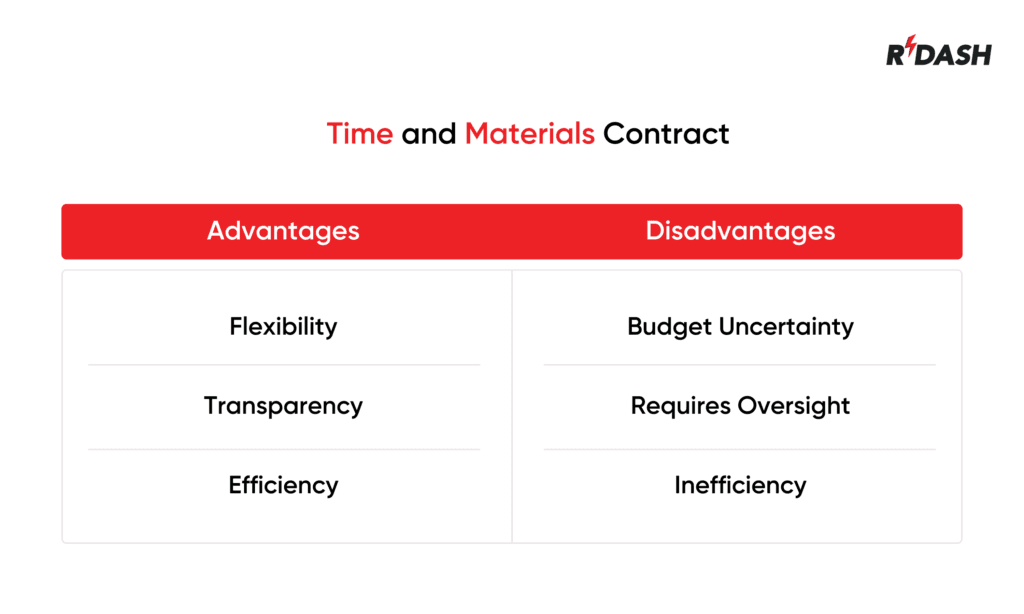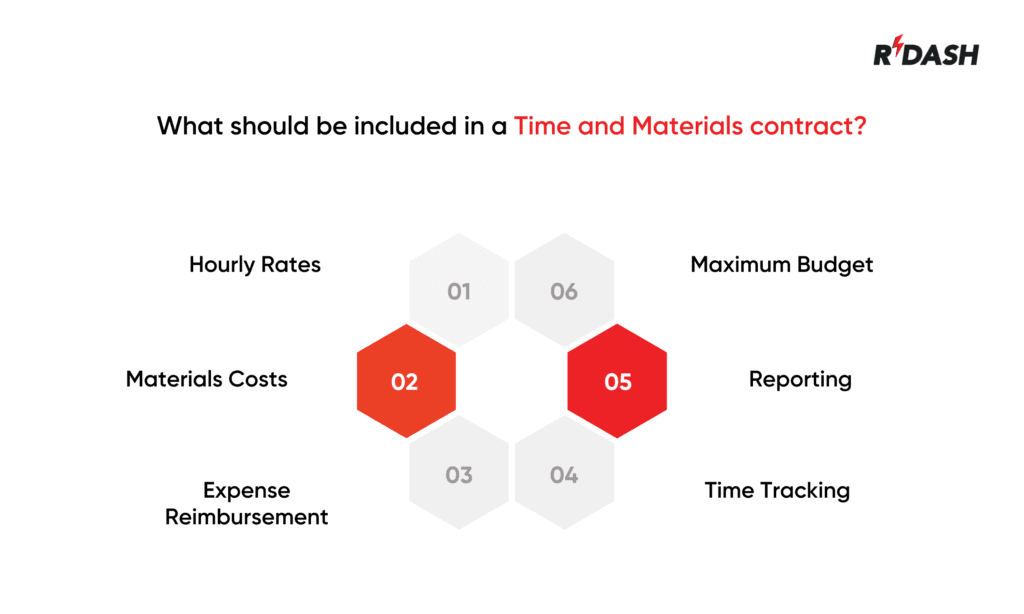What is a Time and Material Contract?
A Time and Material (T&M) contract is a type of agreement commonly used in construction and software development projects where the scope is not clearly defined at the outset. Under this contract, the client pays the contractor based on the actual time spent by the contractor’s employees and subcontractors to perform the work, plus costs for materials and equipment used in the project.
Advantages of Time and Materials Contracts
- Flexibility: T&M contracts allow for more flexibility in managing changes in scope, design, and possible work adjustments. This flexibility is particularly beneficial in projects where the exact requirements are not clear from the beginning.
- Transparency: Clients can see exactly where their money is going, as the contractor is required to keep detailed records of labor and material costs.
- Efficiency: Without the need to bid on a fixed price, contractors can begin work sooner. This can lead to quicker project completion compared to other contract types that require detailed scopes and cost assessments upfront.

Disadvantages of Time and Materials Contracts
- Budget Uncertainty: The biggest drawback is the lack of a fixed budget, which can lead to higher costs if not monitored closely. Without a cap on spending, projects can significantly exceed initial estimates.
- Requires Oversight: Clients must actively oversee the project to ensure that work is done efficiently and expenses are kept in check, which can demand more time and resources than anticipated.
- Potential for Inefficiency: There’s a risk that contractors may not push for the most efficient work method, as the billing is based on time spent rather than completion of specific milestones or project segments.
What should be included in a Time and Materials contract?
A well-structured Time and Materials contract should include several key components to ensure clarity and fairness for both parties involved:

- Hourly Rates: Clearly specify the hourly rates for all personnel categories involved in the project. This includes workers, managers, and specialists.
- Materials Costs: Define how material costs will be calculated and reimbursed. Include provisions for handling any markups or discounts.
- Expense Reimbursement: Outline which types of expenses are reimbursable and the process for approval and reimbursement.
- Time Tracking: Detail the method for tracking time spent by employees on the project to ensure accurate billing.
- Reporting: Include requirements for regular progress reports and financial accounting to keep the client informed.
- Maximum Budget or “Not-to-Exceed” Clause: While not always included, this can be negotiated into the contract to cap the expenses to prevent budget overruns.
How do Time and Materials Contracts work?

Time and Materials contract function on a simple principle: payment is based on the actual time spent on a project and the materials used. Here’s how they typically work:
- Tracking Time: Contractors log hours worked, which are then billed at the agreed rates.
- Recording Costs: Materials purchased for the project are recorded and charged based on the actual expenses incurred.
- Billing: Regular invoices are sent to the client detailing the labor hours, material costs, and any other agreed-upon expenses.
- Ongoing Review: Both parties frequently review the project’s progress and expenditures to ensure alignment with goals and budget.
When to use a Time and Materials Contract?
A Time and Materials contract is most suitable in the following scenarios:
- Uncertain Scope: When the project scope is not well-defined or is expected to change.
- Complex Initiatives: Ideal for projects with significant uncertainties and complexities that make it hard to define the complete scope from the start.
- Short Projects: They are often preferred for smaller or shorter projects where the overhead of setting a fixed-price contract is not justified.
- High Flexibility Requirement: When the client anticipates changes in the project specifications or wants the flexibility to adjust the project scope as work progresses.
Choosing a T&M contract involves balancing the need for flexibility with the potential risks of budget and schedule overruns. It requires diligent management and a good working relationship between the client and the contractor to be effective.
Time and Materials Contract vs. Other Construction Contracts
In the construction industry, contracts are pivotal for outlining the responsibilities, risks, and financial obligations of involved parties. Here’s how Time and Materials (T&M) contracts compare to other common types of construction contracts:
- Fixed-Price Contracts: Unlike T&M contracts where the payment is based on actual labor time and materials used, fixed-price contracts have a set price for the entire project. This provides more budget certainty but less flexibility to adjust scope and requirements.
- Cost-Plus Contracts: Similar to T&M, cost-plus contracts reimburse the contractor for actual costs, plus a percentage or fixed fee as profit. However, these often include a maximum price limit, which T&M contracts might not always have.
- Unit Pricing Contracts: These are used for projects that can be broken down into units. Each unit’s price is agreed upon beforehand, differing from T&M contracts which focus on hourly rates and material costs without a predefined unit cost.
Time and Materials Contract Example
Here’s an example of a Time and Materials contract (T&M) :
- Project Description: Renovation of the client’s commercial space in Mumbai.
- Contractor Details: ABC Renovations Pvt. Ltd., responsible for supplying labor, materials, and all necessary equipment.
- Hourly Rates:
General Labor: ₹500/hour
Electrician: ₹700/hour
Project Manager: ₹1,000/hour
- Materials Costs: Materials will be billed at the actual purchase cost plus a 10% markup to cover procurement and logistics.
- Time Tracking: The contractor will maintain a digital log of all hours worked by each category of employee. These logs are to be verified and approved by the client’s project manager every two weeks.
- Billing and Payment: Invoices will be generated on a monthly basis, providing detailed accounts of all labor hours and materials used. Payments are to be made within 30 days from the date of each invoice.
- Reports: The contractor will submit monthly progress reports outlining detailed work progress, material consumption, and an updated financial statement.
- Maximum Budget Clause: The total expenditure for this project shall not exceed ₹15 lakhs without prior written consent from the client.
This contract framework ensures that the client pays only for the actual work done and materials used, while also setting a cap to control overall project costs, a common practice to manage budget concerns in construction projects.
FAQS
In what situations is a T&M contract ideal?
T&M contracts are best for projects where the full scope of work isn’t clearly defined at the beginning. They are useful for renovation, repair, or custom projects where the amount of work can’t be easily predicted.
How are labor charges handled?
Labor is billed according to hourly or daily rates mentioned in the contract. Rates may differ based on the worker’s role or experience level (for example, a supervisor may cost more than a general laborer).
How are material costs tracked and billed?
Materials are usually billed at cost, and contractors may add a small markup to cover handling or overhead. All material purchases are recorded and shared with the client for transparency.
What does the “time” section of the contract usually involve?
The “time” part typically refers to the hours spent working on the project, which may include on-site labor, planning, supervision, and other agreed-upon activities.
Can the total cost be managed in a Time and Materials contract?
Yes, many clients set a budget limit or cost cap to keep spending under control and avoid unexpected overruns.
How does the client ensure fair billing?
Contractors usually share timesheets and material receipts. Most clients go through weekly updates to monitor project status and spending. Some use project management software to track hours and costs in real time.
Is it possible to convert a T&M contract into a fixed-price agreement later on?
In some cases, projects start with a T&M model and later switch to a fixed-price contract once the full scope of work becomes clear.
Does a Time and Materials contract need to be formally documented in writing?
Absolutely. A written contract helps define the terms, including labor rates, material costs, and billing schedules, and protects both parties throughout the project.
Who usually prefers T&M contracts – clients or contractors?
T&M contracts can benefit both sides. Clients like the flexibility and transparency, while contractors prefer being paid for actual effort and resources. However, it requires mutual trust and good communication.






